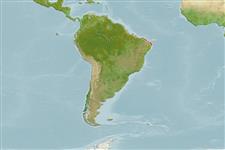>
Blenniiformes (Blennies) >
Dactyloscopidae (Sand stargazers)
Etymology: Platygillellus: Greek, platys = flat + Theodore Nicolas Gill (1837-1914) researcher of abyssal fishes and systematics (Ref. 45335); brasiliensis: Named for its distribution and probably endemic in Brazil..
Environment: milieu / climate zone / depth range / distribution range
นิเวศวิทยา
เกี่ยวกับทะเล,น้ำเค็ม สัตว์น้ำหน้าดิน; ระดับความลึก 1 - 2 m (Ref. 56973). Tropical
Southwest Atlantic: Brazil.
ขนาด / น้ำหนัก / Age
Maturity: Lm ? range ? - ? cm
Max length : 4.1 cm SL เพศผู้/กระเทย; (Ref. 56973); 4.0 cm SL (female)
Short description
สัณฐานวิทยา | ความยาวต่างๆ
Diagnosis: The dorsal finlet is fan-like and 3-spined, its height more than half of predorsal length, 58-84% (vs. 4-spined in P. smithi, low profile in P. rubrocinctus); first 2 spines of finlet more closely spaced than the 2nd and 3rd. Lateral line deflection is usually located below interspace between 14th and 15th dorsal fin elements. Upper lip fimbriae more numerous than those of lower lip. Base of pectoral fin usually naked or rarely with a single scale on its upper portion (Ref. 56973).
Known from shallow reefs; inhabits the margins of sand flats in small caves and below reef walls at depths of 1 to 6 meters; these areas are deposits of coarse gravel largely composed of f fragments of mollusc shells, crustaceans, corals, calcareous algae and sea urchin skeletons and spines. Found buried in the gravel, with just the eyes and the dorsal finlet exposed; it appears to 'swim' in the gravel; solitary or in groups. Associates with other sand-dwelling fishes such as Dactyloscopus tridigitatus, D. crossotus, Gillellus greyae, and toadfish Thallasophynne punctata; also an unidentified shrimp and juveniles of crabs (Callinectes sp.).
Life cycle and mating behavior
วัยเจริญพันธุ์ | การสืบพันธุ์ | การวางไข่ | เซลสืบพันธ์ของเพศเมีย(ไข่) | ความดกของไข่ | ตัวอ่อน
Feitoza, B.M., 2002. Platygillellus brasiliensis n. sp. (Perciformes: Dactyloscopidae), the third species of the genus from the Atlantic. aqua, J. Ichthyol. Aquat. Biol. 6(1):21-28. (Ref. 56973)
IUCN Red List Status (Ref. 130435)
Threat to humans
Harmless
Human uses
ข้อมูลเพิ่มเติม
ชื่อสามัญชื่อพ้องกลไกการเผาผลาญพลังงานผู้ล่าการศึกษาเกี่ยวกับผลกระทบของสารประกอบทางเคมีที่เป็นอันตรายต่อสิ่งมีชีวิต ประชากร และสิ่งแวดล้อมการสืบพันธุ์วัยเจริญพันธุ์การวางไข่การรวมกลุ่มวางไข่ความดกของไข่เซลสืบพันธ์ของเพศเมีย(ไข่)Egg development
Age/SizeการเจริญเติบโตLength-weightLength-lengthLength-frequenciesความยาวต่างๆสัณฐานวิทยาตัวอ่อนพลวัตของสัตว์น้ำวัยอ่อนการทดแทนที่อุดมสมบรูณ์BRUVS
อ้างอิงการเพาะเลี้ยงสัตว์น้ำประวัติการเพาะเลี้ยงสัตว์น้ำสายพันธุ์พันธุศาสตร์ElectrophoresesอัตราพันธุกรรมโรคการแปรรูปNutrientsMass conversion
ผู้ร่วมมือรูปภาพหลายรูปStamps, Coins Misc.เสียงปลามีพิษ เช่น ปลาปักเป้าความเร็วรูปแบบการว่ายน้ำพื้นที่เหงือกOtolithsสมองวิสัยทัศน์
เครื่องมือ
Special reports
Download XML
แหล่งที่มาจากอินเตอร์เน็ต
Estimates based on models
Preferred temperature (Ref.
123201): 27 - 27.6, mean 27.5 °C (based on 44 cells).
Phylogenetic diversity index (Ref.
82804): PD
50 = 0.5156 [Uniqueness, from 0.5 = low to 2.0 = high].
Bayesian length-weight: a=0.00389 (0.00180 - 0.00842), b=3.12 (2.94 - 3.30), in cm total length, based on all LWR estimates for this body shape (Ref.
93245).
ระดับชั้นอาหาร (Ref.
69278): 4.0 ±0.6 se; based on size and trophs of closest relatives
Fishing Vulnerability (Ref.
59153): Low vulnerability (10 of 100).
